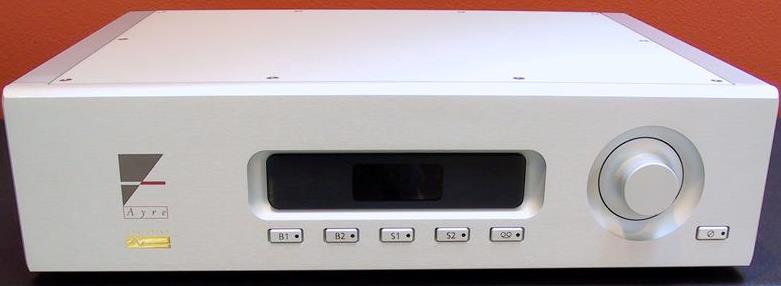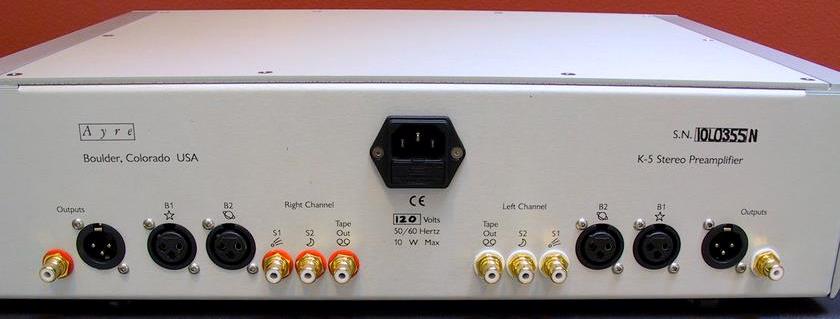The Ayre K-5xe MP line level preamplifier has been in production for about five years and is mostly unchanged since its introduction. These long production lifetimes are standard for Ayre Acoustics which is located in Boulder, Colorado, literally at the foot of the Rocky Mountains. Ayre has consistently produced fine sounding audio components which appear regularly on recommended lists. The top performers and most costly of the Ayre product line is the R series, followed by the 5 series, then the 7 series, and finally the 9 series. The latter is currently occupied only by digital gear which is some of the best sounding available today. Just released is the Anthology series, which is a new entry level line for Ayre. The first new product in that line is the Codex, a DAC + headphone amp + preamp. It has only two digital inputs (USB and TosLink) and retails for $1,795.

The K-5xe MP preamplifier’s current list price is $4,350. There was a period of seven years with no incremental price increases. Other 5 series components are two power amplifiers, an integrated amplifier, another preamp, a phono stage, and a power line filter. The L-5xe power line filter contains a full blown implementation of the Ayre Conditioner AC power filter which “dissipates high frequency interference as harmless thermal energy, delivering pure AC power to your system”, among other features to support an entire system’s power needs. The K-5xe MP preamplifier has a built in Ayre Conditioner which somewhat lessens the impact of different after market power cords.
The K-5xe MP is a full featured line level preamplifier. It has a 66 step volume control with digital readout of volume which is adjustable in 1 dB steps. As noted on the Ayre Web site, the “(i)nput selector also switches ground connection, so that all source components are completely disconnected except for the one selected”. A theater bypass mode is included. This is a relatively low gain device supplying a maximum of 4 dB of gain from the unbalanced RCA outputs and 10 dB of gain from the balanced XLR outputs. There are two balanced inputs, two unbalanced inputs, a fixed level tape output, and one balanced and one unbalanced output connection per channel. The microprocessor used for input switching and volume control is turned off except when actually executing a command.
Other components on hand included a Basis 2500 Signature turntable with Vector 4 tonearm; Miyajima Kansui and Miyajima Madake, ZYX Omega and Universe phono cartridges; Mark Levinson No. 52 preamp with built-in phono, Mark Levinson 326S preamplifier with phono, Krell Phantom III preamp, Prism Orpheus Digital Interface and Lynx Hilo AD/DA converters with custom Windows 7 computer/music server, YG Acoustics Kipod II Signature Main Modules speakers, Magnepan 1.7 and 3.7 speakers, Dali Mentor 5 speakers (from the home theater system), and two Gallo TR-3 and TR-3D subwoofers. The power amplifiers are the very satisfying Acoustic Imagery Atsah monoblocks. All front end components receive their AC power from a PS Audio AV-5000 power conditioner, which is connected to the wall power with a Shunyata Anaconda CX power cord. A PS Audio Quintet power center, which has a 12 Volt trigger input, is connected to the utility grid with another slithering Anaconda CX and is regularly used for the power amplifiers. A variety of power cords are used elsewhere in the system, including Wyred4Sound P1 and Jerry’s DIY power cord.
The preamplifier has a high quality, ergonomic design and weighs a substantial 25 pounds. The only feature I missed was a 12 Volt trigger to turn on other system components. With my mono amps sitting behind the speakers, this is a welcome feature on all modern components. The volume control knob moves smoothly from zero to full output at a reading of 66 with 1 2/3 complete rotations. The Krell pre requires about 10 complete rotations of its volume knob for the same result.
While devotees of classic vacuum tube sound might not be swayed to commit to a long term relationship with the K-5xe MP, this is not a colored sounding preamp. It can exacerbate the sandpapery character of less than pristine recordings in the upper frequencies, but since this is recording-specific and not present on all source material, the blame cannot be justifiably directed at the Ayre. There is little change in the music signal as it travels from input to output.
The sound stage is nicely recreated: very large and specific. The size or volume of the performance venue is readily discernable. As you might expect from Ayre, there is plenty of richly saturated air in the performance space, never a dry or flat sounding presentation. A piano, with its very complex harmonic structure, can sound a bit reserved as if you were seated a few rows farther away than from some other instruments. Occasionally, the dense musical tapestry can sound a little lightweight, although this doesn’t seem to interfere with one’s enjoyment of the performance.
The Ayre preamp offers excellent performance in the bass. The bass is very linear without any changes in character from subterranean floor tremors up to the mid bass around 50-80 Hz. All bass reproduction is a strength of the Ayre. The bass is strong and fast when the music demands it. There is no overlap with adjacent notes and the bass is very focused which prevents any sense of boomy or undefined activity in the lower frequencies.
This very consistent character continues into the midrange. The high resolution and richly saturated bass character is fully present in the midrange where singers are presented with a great sense of natural and lifelike presence. Sure, the $30,000 Levinson No. 52 is even more convincing, but at about 1/10 the cost, the Ayre does a remarkable job of providing enjoyable listening sessions. It is not too difficult to notice the character of the K-5xe MP, but not for long. It inevitably captures the listener’s involvement and your right-brain perceptual side takes over from the left-brain analytical side. Higher level preamps can do some things better, but the K-5xe MP gets the listener far down that road. This is “good Ayre”.

Low level resolution across the board is of a very high standard. For example, in Taylor Swift’s “Begin Again” from her Red CD, her trademark breathy vocals – at least before she went fully pop in the recording titled 1989 – are fully realized. There is an easy understanding of each word with excellent clarity without being dry or thin. There is never a feeling that the upper frequencies degenerate into shrillness or glare, unless these defects are included in the source material. This balance between clarity and purity is critical for the treble to sound correct, and the Ayre gets it right.
The K-5xe MP has excellent pace and drive with superb dynamics. The listener is carried along with the grace and power of the performance. As noted in the review of the $5,500 Krell Phantom III preamp, with its seeming compressed MP-3 download sonic character, the excellent overall performance of the Ayre crushes the Krell preamp for $2,000 less. This is a high value product that easily competes in its price class and above. In fact, where I usually suggest that one probably will get better sound from tubes under the $5,000 ceiling, the Ayre K5-xe MP is a rare exception. It is easily preferable to at least a few tube preamps due to the high resolution and outstanding linearity across the frequency range.
I enjoyed my time with the Ayre K-5xe MP and felt little urgency to reconnect one of the other, much more costly preamps standing by in the current arsenal. This says a lot about the overall musical quality of the Ayre. The high-class case work and excellent ergonomics made it a pleasure to operate on a daily basis. I have high expectations and requirements for any preamplifier to survive listening to for more than a few hours. To paraphrase the expression “time is money”: when listening to music, time is pleasure. I thoroughly dislike wasting either one due to marginal sounding gear. The Ayre K-5xe MP passed this tough benchmark and consistently proved to be an enjoyable and involving component.
Overall Rating: 9 LPs
Link to manufacturer: Ayre Acoustics
